地球流体セミナー/
Workshop on Climate Modeling and Satellite Observations
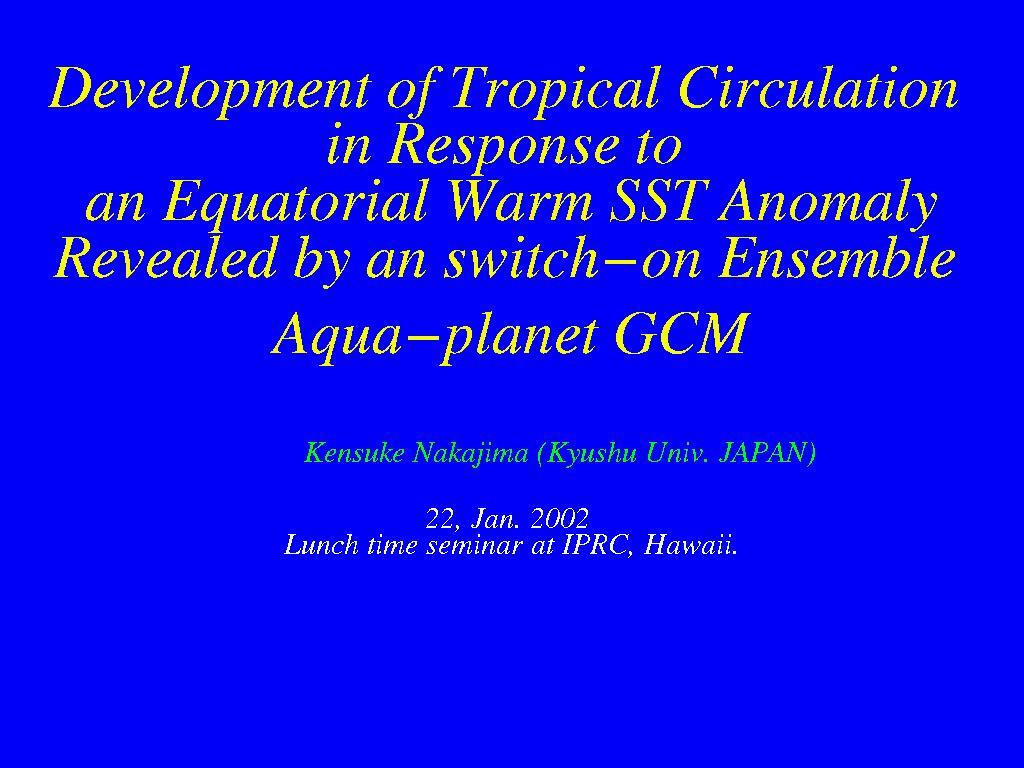
|
Development of Tropical Circulation
in Response to an Equatorial Warm SST Anomaly
Revealed by an switch-on Ensemble Aqua-planet GCM
Department of Earth and Planetary Sciences, Kushu University
Kensuke Nakjima
kensuke@geo.kyushu-u.ac.jp
22nd, Jan., 2002
|
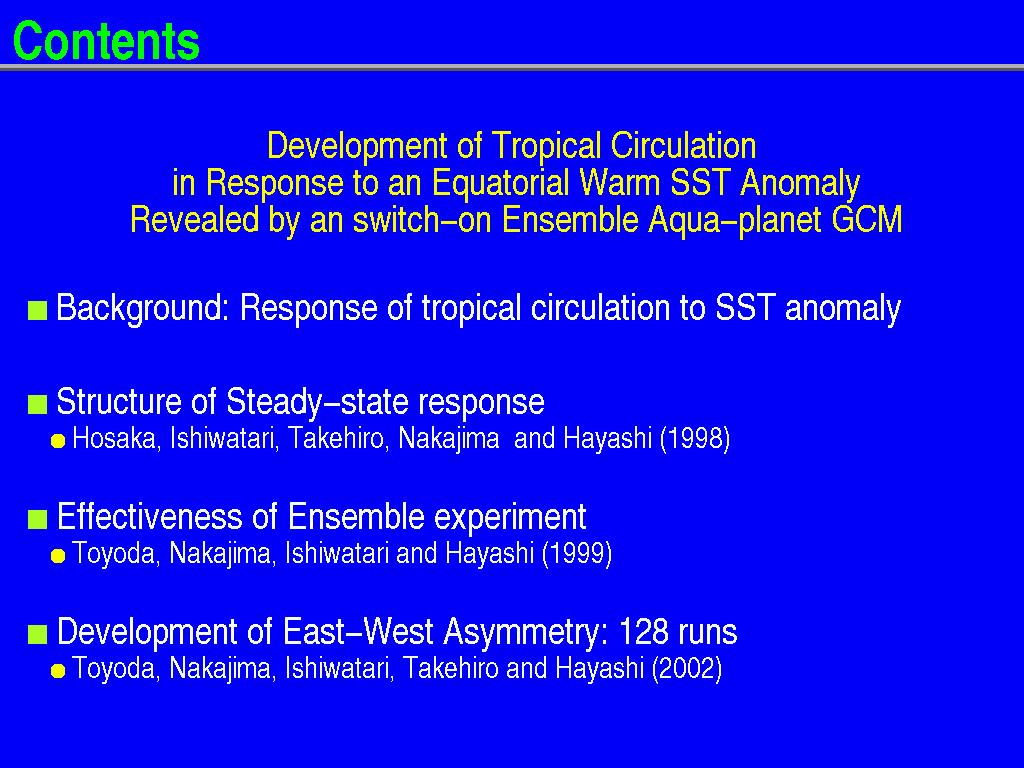
|
Contens
|

|
Introduction: where does rain fall occur in toropics?
|
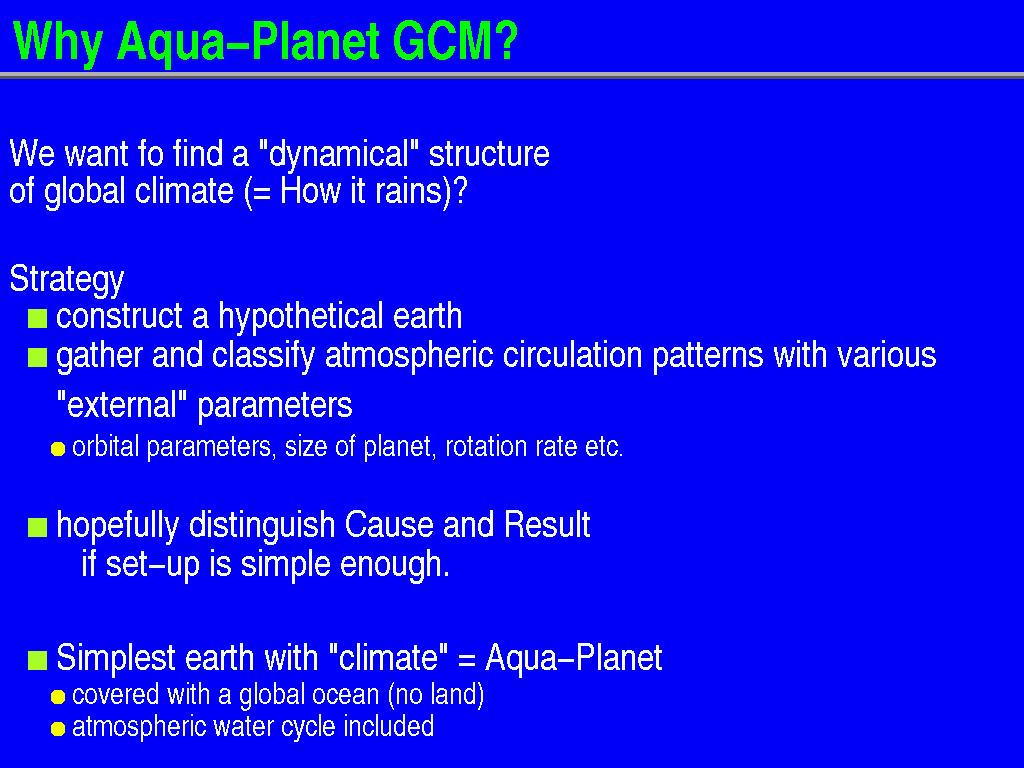
|
Introduction: Why do we use aqua-planet GCM?
|

|
Introduction: previous studies which used aqua-planet GCM.
|
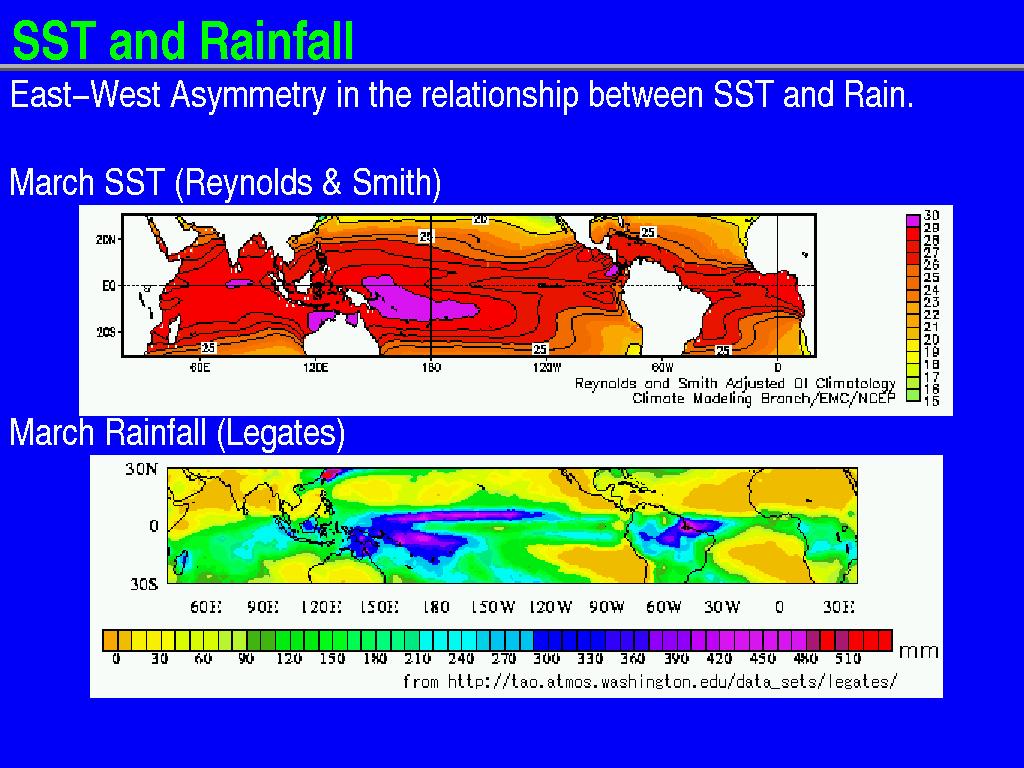
|
Introduction: observations of SST and precipitation distributions
|

|
Result obtained by Gill (1980).
|
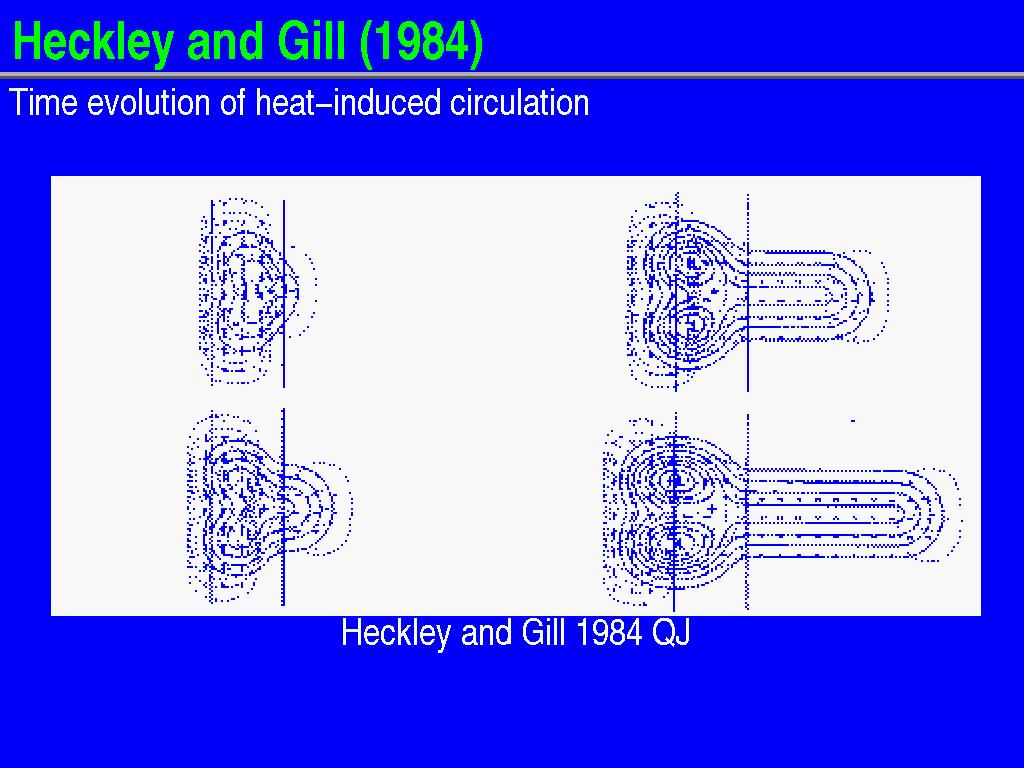
|
Result obtained by Heckley and Gill (1984).
|

|
Question: How about can the results of Gill (1980) be modified ?
|

|
Description of our numerical model: GFD Dennou Club AGCM ver. 5
|

|
Boundary condition: SST distribution
- put warm patch on the equator, where temperature anomaly is 4 K.
|

|
Reslut: horizontal distribution of precipitation (after 2000 day and
50 days mean).
|
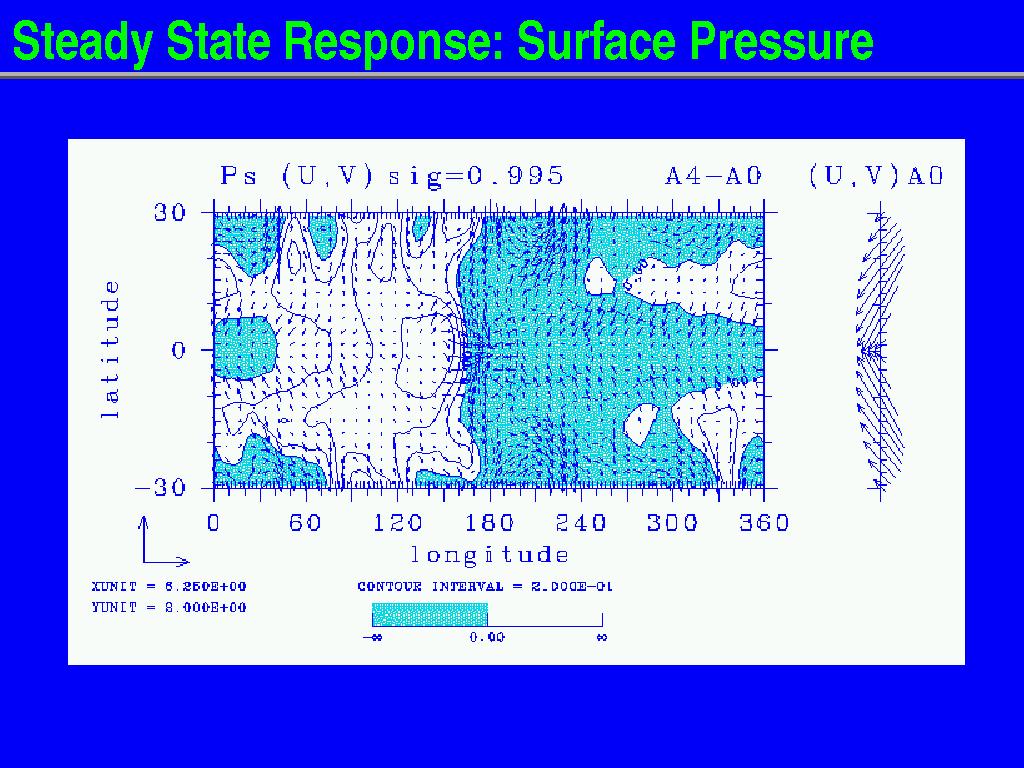
|
Reslut: horizontal distribution of surface pressure (after 2000 day and
50 days mean).
|
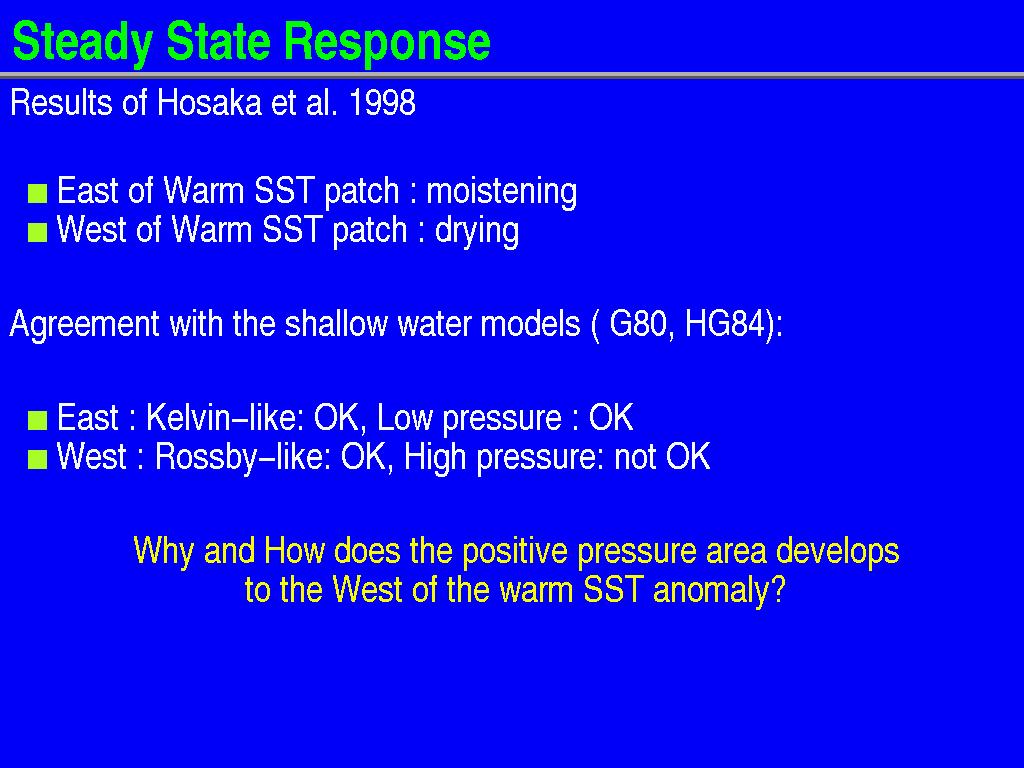
|
Steady state responce
- west of the warm SST patch: Kelvin response
- east of the warm SST patch: Rossby response ?
|

|
Time averaged structure
- upper left : horizontal wind and geopotential hight anomaly at σ=0.175
- upper right: temperature anomaly at σ=0.175
- lower left : zonal and vertical wind and temperature anomaly at equator
- lower right: horizontal wind and surface pressure anomaly at σ=0.995
|
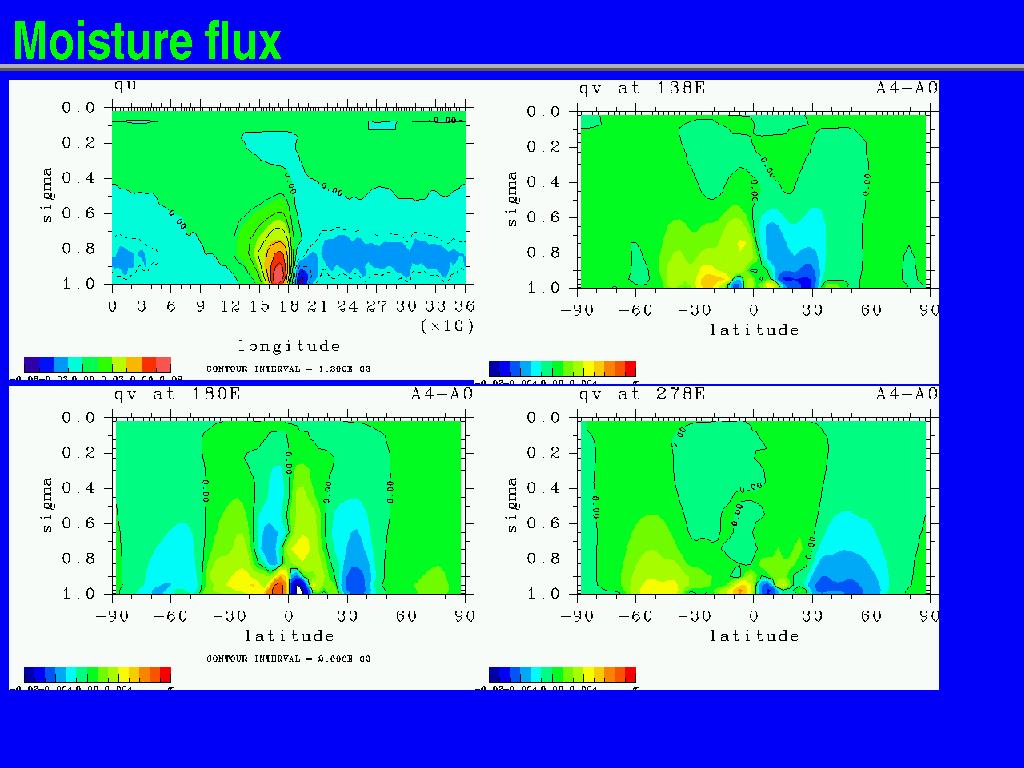
|
Moisture flux
- upper left : qu at equator (longitude-hight cross section)
- upper right: qv at 138 E (latitude-hight cross section)
- lower left : qv at 180 E (latitude-hight cross section)
- lower right: qv at 278 E (latitude-hight cross section)
|
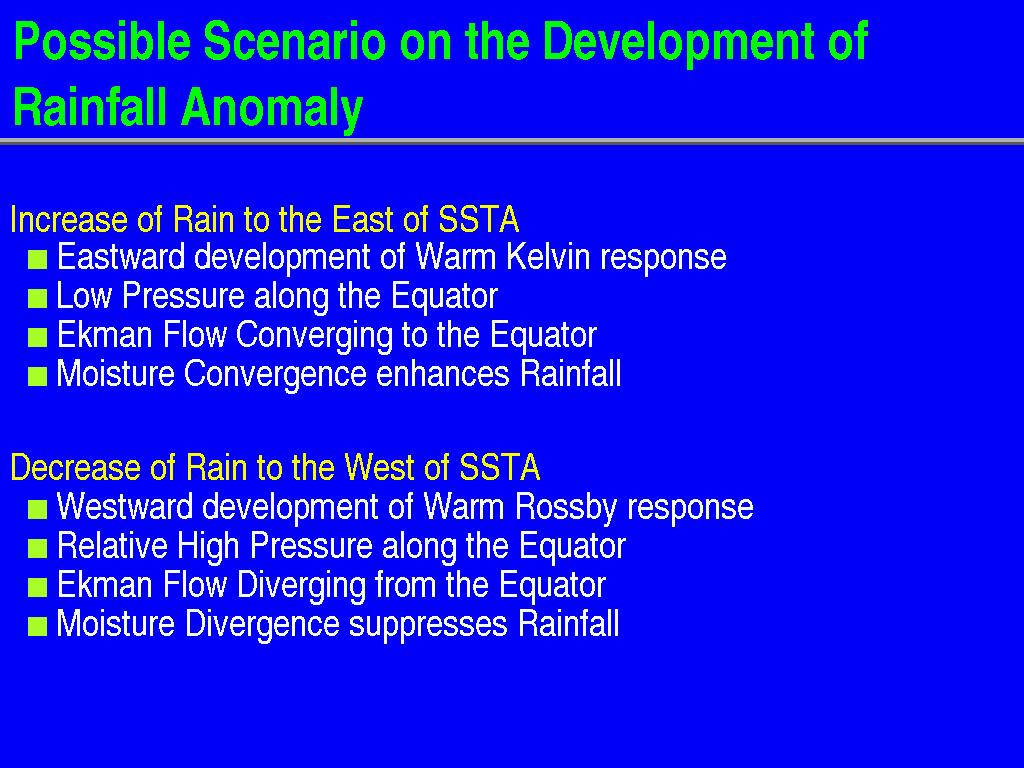
|
Summary of the steady state response.
|

|
Outline of the ensemble experiment (1)
|
Resluts of the ensemble experiment (1)

|
Summay of the ensemble experiment (1)
|

|
Outline of the ensemble experiment (2)
|
Resluts of the ensemble experiment (2)
Resluts of the ensemble experiment (2) [mpeg movie]
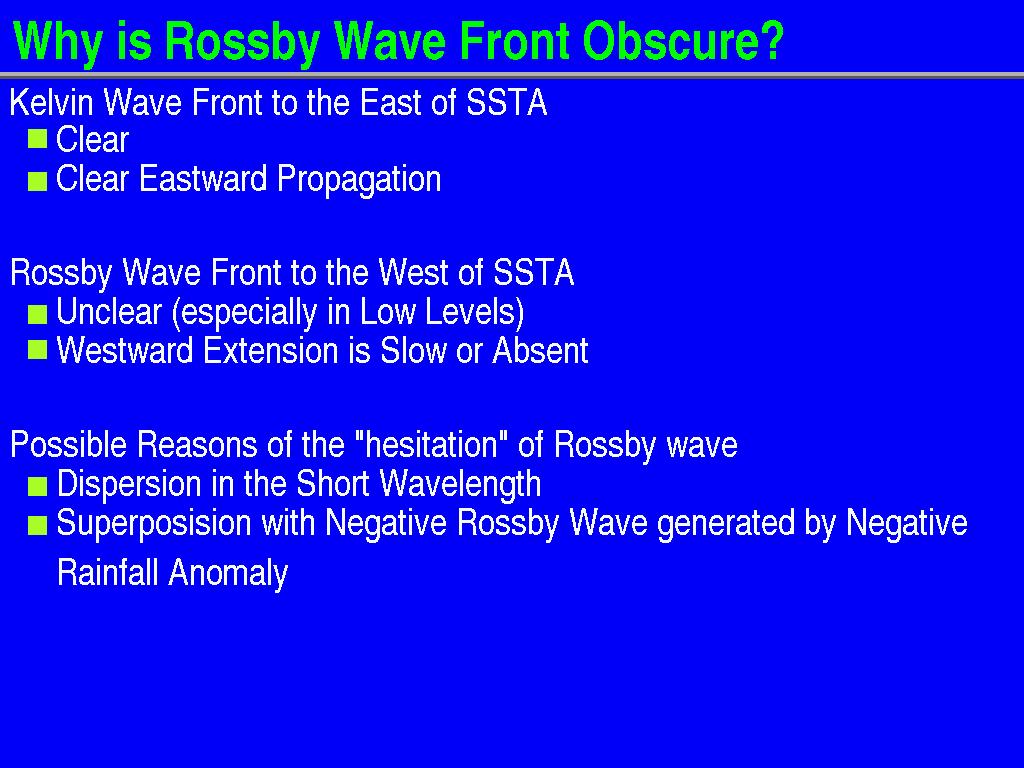
|
Summary of the ensemble experiment (2)
- Kelvin response is clearly observed, but Rossby response is obscure.
- Why ?
- The negative heating due to drying in the west region of the warm
SST patch weakens the Rossby wave which is excited by the warm SST
patch.
- Dispersion relation of the equatorial Rossby wave:
The group velocity of short equatorial Rossby wave is eastward.
- Gill (1980) and Heckley and Gill (1984) use long wave approximation
(re-calculation result of Heckley and Gill (1984) without long
wave approximation is hear).
|
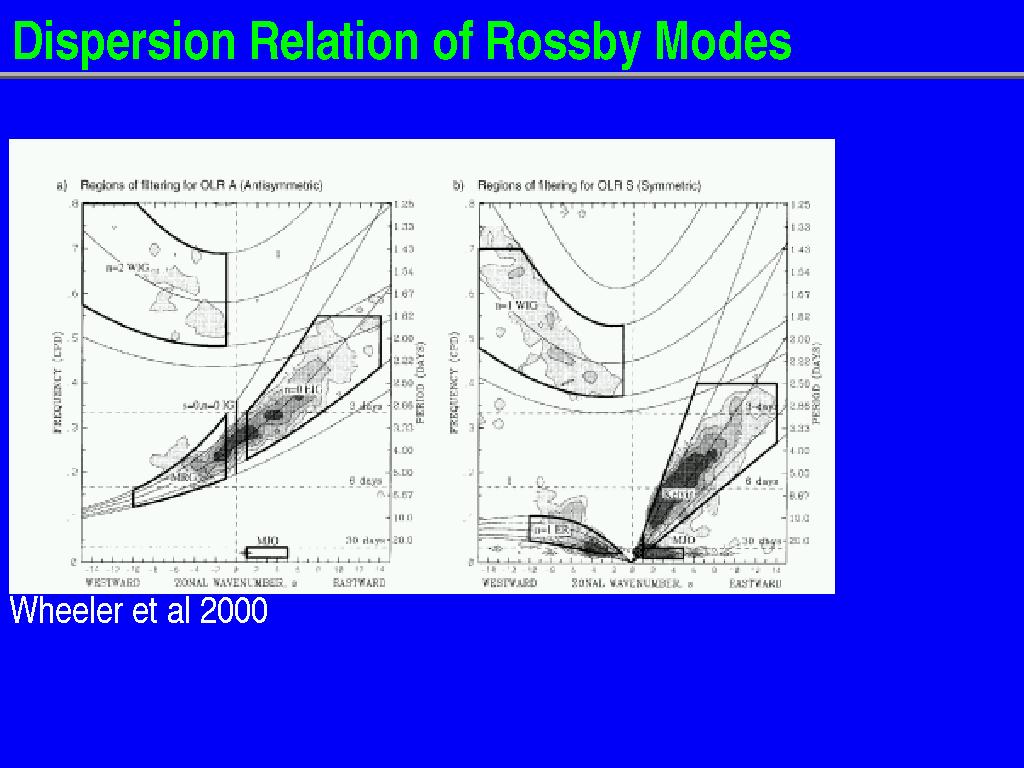
|
Dispersion relation of the equatorial wavw
- The group velocity of short equatorial Rossby wave is eastward.
|
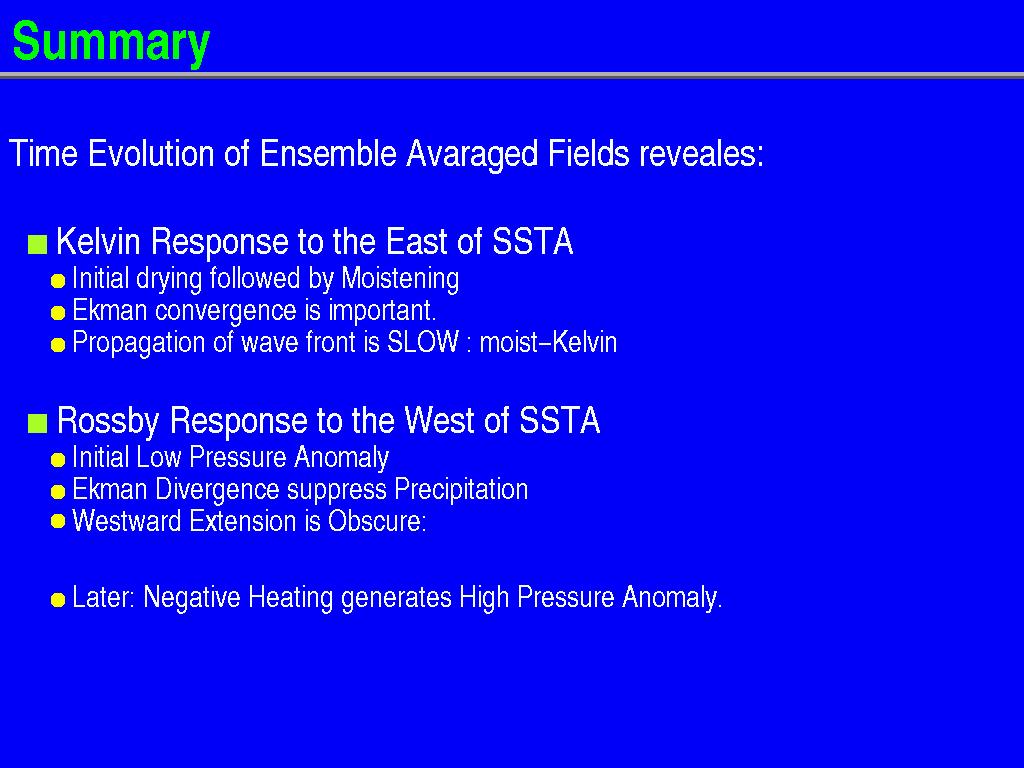
|
Summary
|
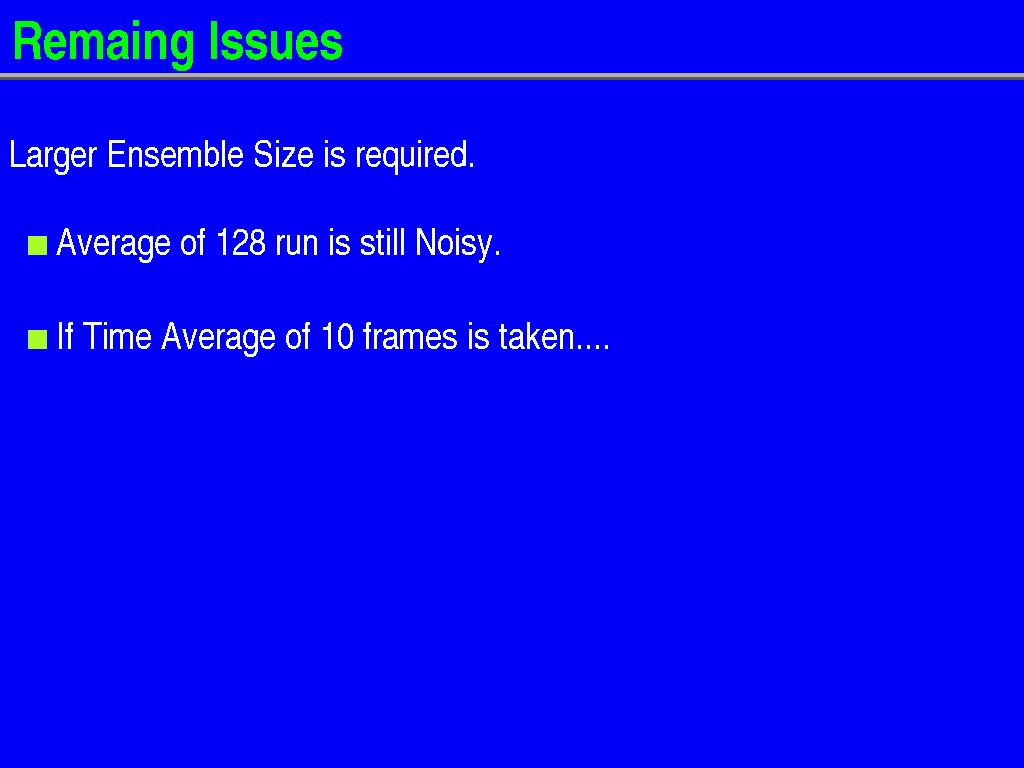
|
Future ploblem (1)
|
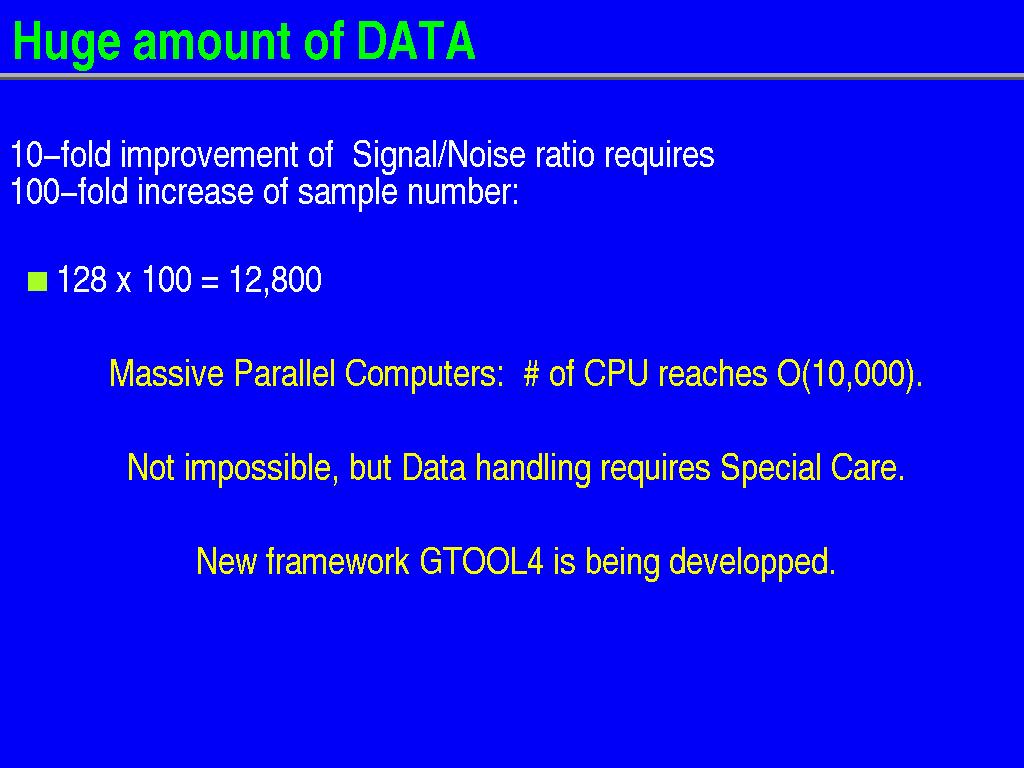
|
Future ploblem (2)
|

|
References
|
References
- Gill, A. E., 1980:
Some simple solutions for heat-induced tropical circulation.
Quart. J. Roy. Meteorol. Soc., 106, 447-462.
- Heckley, W. A., and A. E. Gill, 1984:
Some simple analytical solutions to the problems of
forced equatorial long waves.
Quart. J. Roy. Meteorol. Soc., 110, 203-217.
- Hayashi, Y.-Y. and A. Sumi, 1986:
The 30-40 day oscillations simulated in an ``aqua planet'' model.
J. Meteor. Soc. Japan, 64, 451-467.
- Hosaka, M., M. Ishiwatari, S. Takehiro, K. Nakajima, and
Y.-Y. Hayashi, 1998:
Tropical precipitation patterns in response to a local warm
SST area placed at the equator of an Aqua planet.
J. Meteor. Soc. Japan, 76, 289-305.
- Numaguti, A., and Y.-Y. Hayashi, 1991:
Behavior of cumulus activity and the structures of
circulations in an aqua planet mode. 2. Eastward-moving
planetary scale structure and the intertropical convergence
zone. J. Meteor. Soc. Japan, 69, 563-579.
- Numaguti, A., 1992: Numerical experiments on the large scale
structure of cumulus activity in the tropics. Ph.D. Thesis,
University of Tokyo. (in Japanese).
- Numaguti, A., 1993:
Dynamics and energy-balance of the Hadley circulation and the
tropical precipitation zones - significance of the
distribution of evaporation.
J. Atmos. Sci., 50, 1874-1887.
- Kodama, Y. M., 1999: Roles of the atmospheric heat sources in
maintaining the subtropical convergence zones: An aqua-planet
GCM study. J. Atmos. Sci., 56, 4032-4049.
- Takayabu, Y. N., 1994:
Large-scale cloud disturbances associated with equatorial waves.
1. Spectral features of the cloud disturbances,
J. Meteor. Soc. Japan, 72, 433-449.
- Takayabu, Y. N., 1994:
Large-scale cloud disturbances associated with equatorial waves.
2. Weastward-propagating inertio-grabity waves,
J. Meteor. Soc. Japan, 72, 451-465.
- Toyoda, E., K. Nakajima, M. Ishiwatari, and Y,-Y. Hayashi, 1999:
Response of the tropical atmosphere to a localized warm SST
area: Time-development observed in an aqua-planet ensemble
experiment. Nagare Multimedia
http://www.nagare.or.jp/mm/99/toyoda/.
- Wheeler M, G. N. Kiladis, and P. J. Webster, 2002:
Large-scale dynamical fields associated with convectively coupled
equatorial waves, J. Atmos. Sci., 57, 613-640.
- TRMM: http://www.eorc.nasda.go.jp/TRMM/Gallery/tev/pdf/tev_11.pdf
Odaka Masatsugu
2002-01-20
|